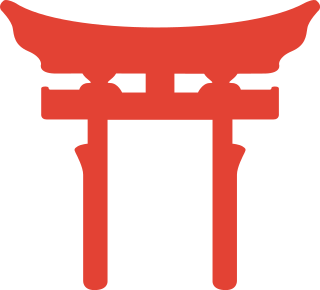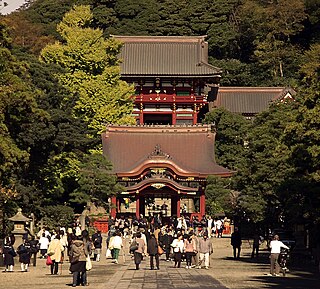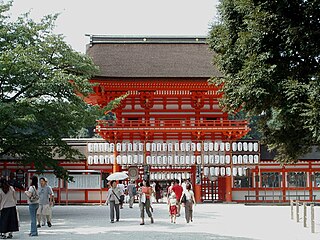
A torii is a traditional Japanese gate most commonly found at the entrance of or within a Shinto shrine, where it symbolically marks the transition from the mundane to the sacred.

Inari Ōkami, also called Ō-Inari (大稲荷), is the Japanese kami of foxes, fertility, rice, tea and sake, of agriculture and industry, of general prosperity and worldly success, and one of the principal kami of Shinto. In earlier Japan, Inari was also the patron of swordsmiths and merchants. Represented as male, female, or androgynous, Inari is sometimes seen as a collective of three or five individual kami. Inari appears to have been worshipped since the founding of a shrine at Inari Mountain in 711 AD, although some scholars believe that worship started in the late 5th century.

Itsukushima Shrine is a Shinto shrine on the island of Itsukushima, best known for its "floating" torii gate. It is in the city of Hatsukaichi in Hiroshima Prefecture in Japan. The shrine complex is listed as a UNESCO World Heritage Site, and the Japanese government has designated several buildings and possessions as National Treasures.

Kasuga Grand Shrine is a Shinto shrine in Nara, Nara Prefecture, Japan. It is the shrine of the Fujiwara family, established in 768 CE and rebuilt several times over the centuries. The interior is famous for its many bronze lanterns, as well as the many stone lanterns that lead up the shrine.

A Shinto shrine is a structure whose main purpose is to house ("enshrine") one or more kami. Its most important building is used for the safekeeping of sacred objects and not for worship. Although only one word ("shrine") is used in English, in Japanese, Shinto shrines may carry any one of many different, non-equivalent names like gongen, -gū, jinja, jingū, mori, myōjin, -sha, taisha, ubusuna or yashiro.

Fushimi Inari-taisha (伏見稲荷大社) is the head shrine of the kami Inari, located in Fushimi-ku, Kyoto, Kyoto Prefecture, Japan. The shrine sits at the base of a mountain also named Inari which is 233 metres (764 ft) above sea level, and includes trails up the mountain to many smaller shrines which span 4 kilometres (2.5 mi) and take approximately 2 hours to walk up.

Tsurugaoka Hachimangū (鶴岡八幡宮) is the most important Shinto shrine in the city of Kamakura, Kanagawa Prefecture, Japan. The shrine is a cultural center of the city of Kamakura and serves as the venue of many of its most important festivals with two museums.
An Inari shrine is a type of Japanese shrine used to worship the kami Inari. Inari is a popular deity associated with foxes, rice, household wellbeing, business prosperity, and general prosperity. Inari shrines are typically constructed of white stucco walls with red-lacquered woodwork, and their entrances are marked by vermilion torii. Both Buddhist and Shinto Inari shrines are located throughout Japan.

The Izumo Taishakyo Mission is a Shinto shrine located in downtown Honolulu, Hawaii. It is one of the few active Shinto shrines in the United States. The wooden A-frame structure was inspired by Shimane Prefecture's classical Japanese shrine Izumo Taisha. It was designed by architect Hego Fuchino and built by master carpenter Ichisaburo Takata.

Kamigamo Shrine is an important Shinto sanctuary on the banks of the Kamo River in north Kyoto, first founded in 678. Its formal name is the Kamo-wakeikazuchi Shrine.

Shimogamo Shrine is an important Shinto sanctuary in the Shimogamo district of Kyoto city's Sakyō ward. Its formal name is Kamo-mioya-jinja (賀茂御祖神社). It is one of the oldest Shinto shrines in Japan and is one of the seventeen Historic Monuments of Ancient Kyoto which have been designated by UNESCO as a World Heritage Site. The term Kamo-jinja in Japanese is a general reference to Shimogamo Shrine and Kamigamo Shrine, the traditionally linked Kamo shrines of Kyoto; Shimogamo is the older of the pair, being believed to be 100 years older than Kamigamo, and dating to the 6th century, centuries before Kyoto became the capital of Japan. The Kamo-jinja serve the function of protecting Kyoto from malign influences.

Komainu (狛犬), often called lion-dogs in English, are statue pairs of lion-like creatures either guarding the entrance or the honden, or inner shrine of many Japanese Shinto shrines or kept inside the inner shrine itself, where they are not visible to the public. The first type, born during the Edo period, is called sandō komainu, the second and much older type jinnai komainu. They can sometimes be found also at Buddhist temples, nobility residences or even private homes.

Hiyoshi Taisha (日吉大社) is a Shinto shrine located in the city of Ōtsu, Shiga Prefecture Japan. This shrine is one of the Twenty-Two Shrines. Known before World War II as Hiei Taisha (日枝大社) or Hie jinja, "Hiyoshi" is now the preferred spelling. It was also known as the Sannō Gongen (山王権現). The head shrine in Ōtsu heads the seventh largest shrine network in Japan, with approximately 3800 Hiyoshi, Hie, and Sannō shrines nationwide. Torii of this shrine have a distinctive configuration, known as the "Sannō torii", with a gaggle above the main crossbeam. The 400,000 square meter precincts centered is designated as a National Historic Site, and the east and west main shrine buildings, the Nishi Hongū (西本宮) and Higashi Hongū (東本宮) are designated as National Treasures, and many of the structures in the precincts are designated as National Important Cultural Properties.

The Hanazono Shrine is a Shinto shrine located in Shinjuku, Tokyo, Japan. This shrine was founded in the mid-17th century. Hanazono Jinja nestled in the heart of Tokyo's Shinjuku ward, Hanazono Jinja is a small and unobtrusive structure that, according to Fodor's, just happens to be one of the most historical shrines in Japan. Constructed in the Edo period by the Hanazono family, this Inari shrine—a shrine dedicated to Inari, the androgynous god of fertility and worldly success—is a favorite place for businessmen to pray for successful ventures.

Nezu Shrine is a Shinto shrine located in the Bunkyō ward of Tokyo, Japan.

Kanjō (勧請) in Shinto terminology indicates a propagation process through which a kami, previously divided through a process called bunrei, is invited to another location and there re-enshrined.

Toyokawa Inari (豊川稲荷) is the popular name for a Buddhist temple of the Sōtō sect located in the city of Toyokawa in eastern Aichi Prefecture, Japan. The temple’s true name is 妙厳寺, or full name is Enpukuzan Toyokawa-kaku, Myōgon-ji. Despite the torii gate at the entrance, and the popular identification of its main image of veneration with Inari Okami, the Shinto kami of fertility, rice, agriculture, industry and worldly success, the institution is a Buddhist temple and has no overt association with the Shinto religion.

Ōmiwa Shrine, also known as Miwa Shrine, is a Shinto shrine located in Sakurai, Nara Prefecture, Japan. The shrine is noted because it contains no sacred images or objects because it is believed to serve Mount Miwa, the mountain on which it stands. For the same reason, it has a worship hall, but no place for the deity to be housed. In this sense, it is a model of what the first Shinto shrines were like. Ōmiwa Shrine is one of the oldest extant Shinto shrines in Japan and the site has been sacred ground for some of the earliest religious practices in Japan. Because of this, it has sometimes been named as Japan's first shrine. Ōmiwa Shrine is a tutelary shrine of the Japanese sake brewers.
Gedatsu Church of America is an American Buddhist church with branches in Japan, Sacramento, Los Angeles, and Hawaii. A nonsectarian spiritual movement, it is based on the Japanese Gedatsu-kai, a new religious movement that was founded in 1929 by Seiken Okano. The Church preaches about Gedatsu-kai, a religious study dedicated toward promoting total inner peace and spiritual enlightenment. Gedatsu is the Japanese term for moksha or enlightenment.

Kameoka Hachimangū (亀岡八幡宮) is a Shinto shrine in Aoba-ku, Sendai, Miyagi, Japan. It is the tutelary shrine of the Date clan.























